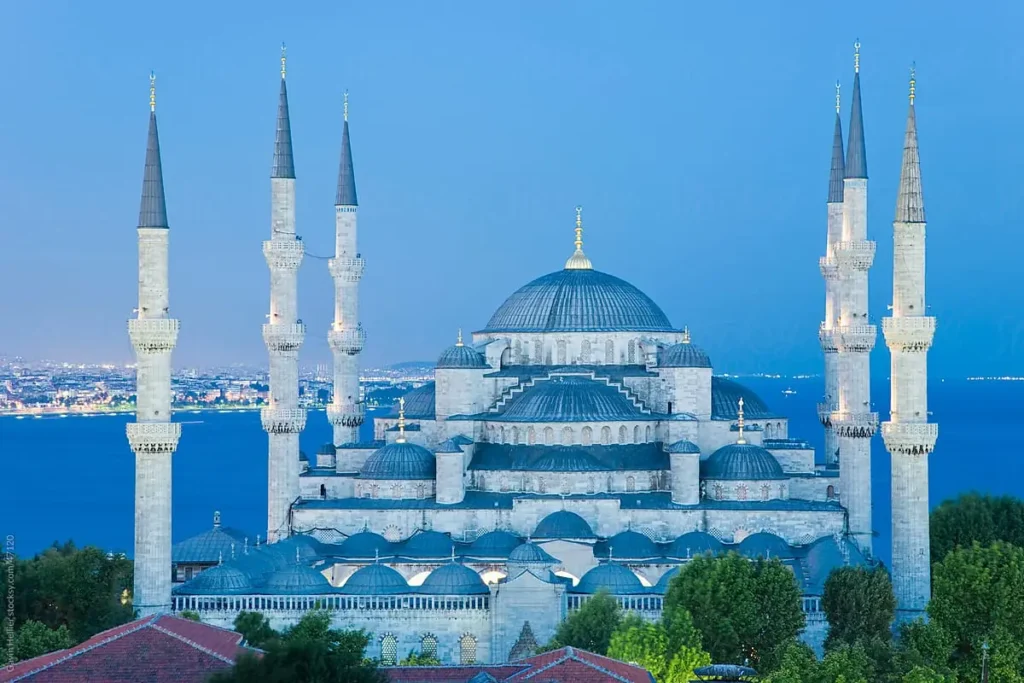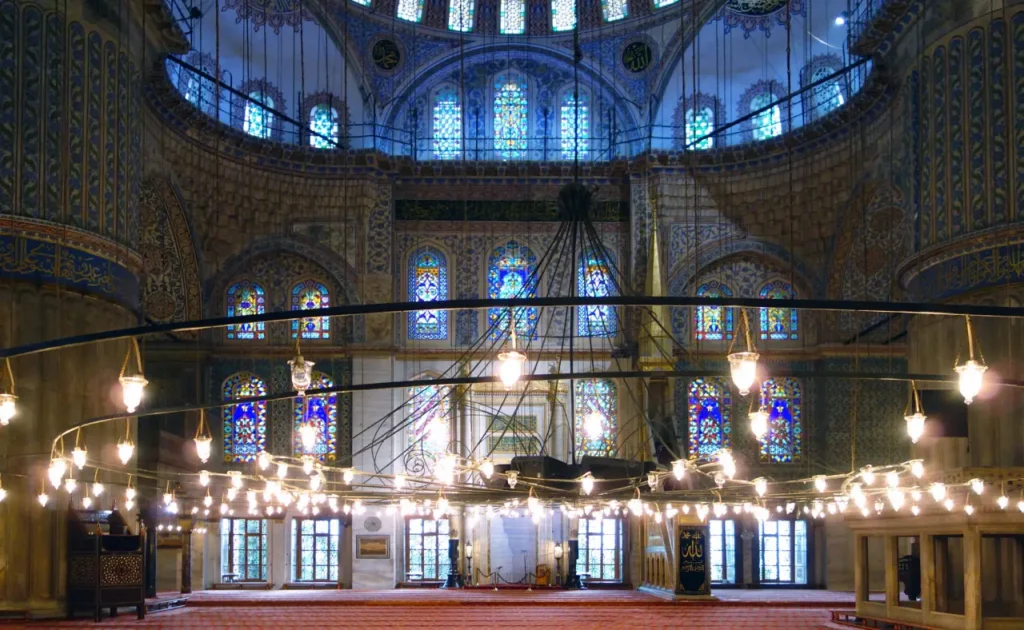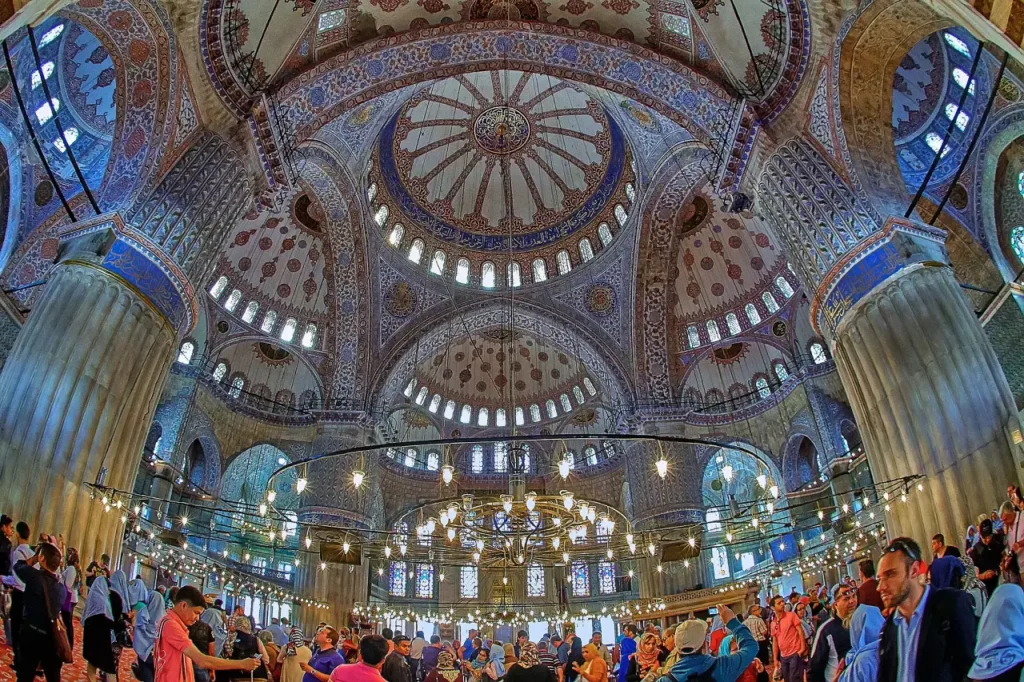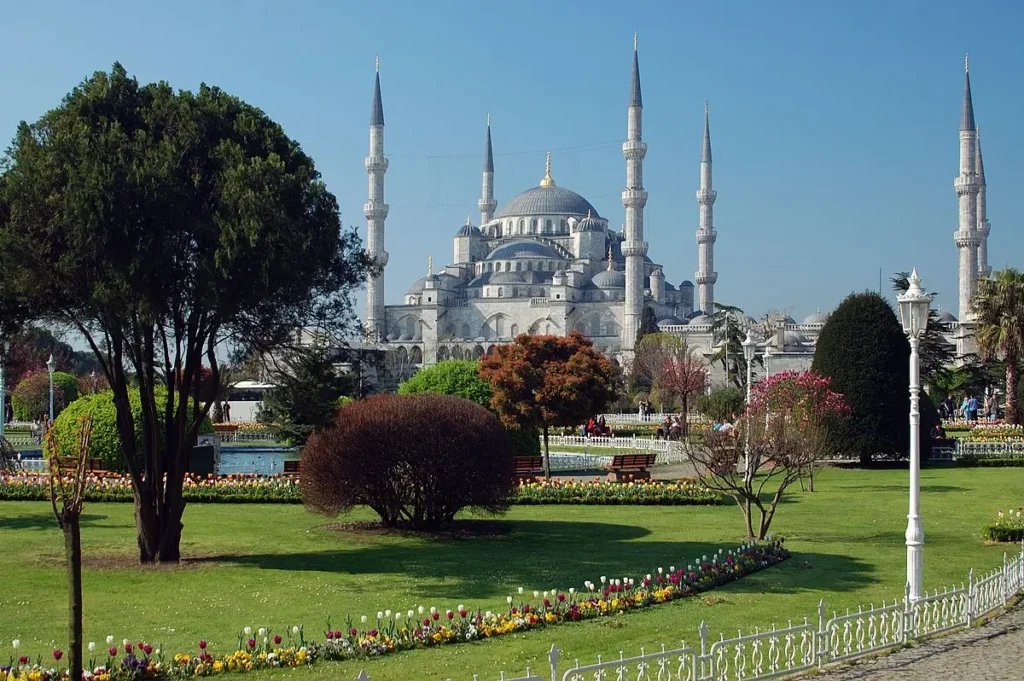The Blue Mosque
A Historical Overview of The Blue Mosque
The Blue Mosque, officially known as Sultan Ahmed Mosque, is a historical marvel that stands majestically in Istanbul Turkey Sultanahmet District. Commissioned by Sultan Ahmed I, its construction spanned from 1609 to 1616, during a period known for architectural innovation and cultural renaissance in the Ottoman Empire. The mosque was designed by the eminent architect Sedefkâr Mehmed Ağa, a student of Sinan, the chief Ottoman architect renowned for shaping the skyline of Istanbul. Built to rival the grandeur of the nearby Hagia Sophia, the Blue Mosque has not only fulfilled its original purpose but has also emerged as an enduring symbol of Istanbul’s rich historical tapestry, attracting millions of visitors and faithful from around the globe.
Architectural Significance of The Blue Mosque
The architectural significance of the Blue Mosque lies in its harmonious blend of Byzantine Christian elements with traditional Islamic architecture, a testament to Istanbul’s role as a melting pot of cultures and civilizations. The mosque’s most striking feature is its six slender minarets, a number unprecedented in Ottoman architecture at the time, which caused controversy and required the addition of a seventh minaret to the Masjid al-Haram in Mecca to restore its supremacy.
The interior of the mosque is no less impressive, with its high central dome, semi-domes, and six smaller domes creating a vertical and horizontal spaciousness that is both divine and awe-inspiring. The use of more than 20,000 handmade ceramic tiles in hues of blue, green, and red-brown, and the incorporation of 200 stained glass windows that allow natural light to enhance the interior’s intricate designs, makes a visit to the Blue Mosque a visually stunning experience. The mosque’s name, often attributed to these blue tiles, also reflects the peace and serenity that visitors feel within its walls, making it not just an architectural marvel, but a spiritual haven.
Visiting the Blue Mosque

Best Times to Visit The Blue Mosque
The Blue Mosque is not only a significant historical monument but also an active place of worship. The best time to visit is mid-morning or late afternoon, avoiding the prayer times, particularly the midday prayer on Fridays which tends to be the busiest. During the holy month of Ramadan , the mosque is especially vibrant, adorned with lights and frequented by worshippers, but it also becomes more crowded. Visiting outside of prayer times allows tourists to experience the tranquil ambiance and architectural beauty without disturbing the sanctity of the mosque. The early hours just after opening can offer a more peaceful experience, and the light at this time beautifully highlights the mosque’s intricate designs. Do you wonder When is Ramadan 2025?
Entry Guidelines and Dress Code of The Blue Mosque
Entrance to the Blue Mosque is free of charge, but respect for its sanctity as a place of worship is paramount. Visitors should be aware that the mosque is close to non-worshippers for half an hour during the five daily prayers. It’s advisable to check the prayer times in advance.
As for the dress code, modesty is key. Both men and women are to dress appropriately:
- For Men: Shorts are not allowed. Men should wear long pants.
- For Women: A headscarf is a must, and clothing should cover the arms, legs, and décolleté. If you don’t wear something appropriate, scarves and fabrics are usually provided at the entrance.
Shoes must be removed before entering the carpeted prayer area, and bags are provided to carry your footwear with you. Photography is allowed, but it’s respectful to avoid flash and remain discreet, especially when the mosque is crowded or during prayer times. Quiet and respectful behavior is expected within the mosque to maintain the sacred atmosphere and allow all visitors and worshippers to have a serene and spiritual experience.
The Interior of the Blue Mosque

The Significance of Blue Tiles
The interior of the Blue Mosque is a testament to the artistic and cultural zenith of the Ottoman Empire. The mosque earns its name ‘Blue Mosque’ from the over 20,000 handmade İznik tiles that adorn its interior, featuring various tulip, rose, carnation, and lily designs, which were popular motifs of the Ottoman period. These tiles, with their dominant blue hues, embellish the walls, ceilings, and upper levels, casting a tranquil and meditative ambiance within the mosque. The color blue, in many cultures, is associated with the sky and the divine. In the Blue Mosque, the blue tiles seem to merge the earthly with the celestial, inviting worshippers and visitors alike to reflect, pray, and meditate in what feels like an ethereal setting.
Calligraphy and Ornamentation

The calligraphy and ornamentation within the Blue Mosque are unparalleled in their beauty and intricacy. The walls are full with verses from the Quran, meticulously crafted by the famous calligrapher Seyyid Kasim Gubari. The calligraphy, primarily in the thuluth script, includes the names of the caliphs and verses from the Quran, each chosen thoughtfully to remind worshippers of the teachings and virtues of Islam.
Apart from the calligraphy, the interior features exquisite floral and geometric ornamentation, which, together with the tiles, creates a mesmerizing visual spectacle. The use of light is another masterful element of the mosque’s design. The 260 windows, some stained with 17th-century glass, allow natural light to filter in subtly, illuminating the interior and highlighting the intricate designs, creating a serene and divine atmosphere. This interplay of light and shadow, combined with the artistry of the tiles and calligraphy, makes the interior of the Blue Mosque a true masterpiece of Ottoman art and architecture.
The Exterior and Courtyard of the Blue Mosque
Minarets and Domes of The Blue Mosque
The exterior of the Blue Mosque presents an awe-inspiring panorama that is as majestic as its interior. The mosque is famously famous for its six minarets, a feature that was unique at the time of its construction and led to its distinction among other mosques of the era. These slender, rocket-shaped minarets soar into the sky, symbolizing the mosque’s spiritual reach. The main dome, impressively large with a diameter of 23.5 meters and a height of 43 meters, is flanked by semi-domes, creating a cascading effect that enhances the mosque’s visual impact. The domes, with their stacked arrangement, not only contribute to the mosque’s grandeur but also play a crucial role in the acoustics within the prayer hall, ensuring that the imam’s voice is heard by all worshippers.
The Courtyard: A Space for Serenity

The courtyard of the Blue Mosque is an integral part of its design, offering a space of tranquility and reflection. Enclosed by a portico with small domes, the courtyard is almost as large as the mosque itself, providing a sense of balance and harmony. The central ablution fountain, where worshippers perform ritual purification before prayers, adds to the spiritual ambiance of the space. The courtyard, with its columns and arches, offers a splendid view of the mosque’s façade, allowing visitors to appreciate the intricate details and craftsmanship. The geometric patterns on the courtyard floor, together with the landscaped gardens and the open sky, create a serene and inviting atmosphere, making it a perfect place for contemplation and admiration of the mosque’s architectural beauty.
Cultural and Religious Significance of the Blue Mosque
The Blue Mosque in Islamic Tradition
The Blue Mosque holds a prestigious place in Islamic tradition, serving not only as a place of daily worship but also as a significant landmark in the religious landscape of Istanbul and the wider Muslim world. Its construction during the early 17th century was to reaffirm the strength and commitment of the Ottoman Empire to Islamic art and spirituality. The mosque’s design, which incorporates both Byzantine Christian elements and traditional Islamic architecture, symbolizes a continuation and evolution of a cultural and religious heritage that dates back to the conquest of Constantinople.
As one of the few mosques with six minarets, the Blue Mosque stands in a league of its own, reflecting the historical significance and the religious devotion of the Ottoman rulers. The mosque also serves as a gathering place during major religious events like Ramadan and Eid, drawing worshippers from across the globe, thereby reinforcing the sense of unity and brotherhood prescribed in Islamic teachings.
The Mosque as a Cultural Hub
Beyond its religious significance, the Blue Mosque is a pivotal cultural icon of Istanbul. It is not just a monument of the past but a living, breathing entity that continues to resonate with the cultural dynamics of the present. The mosque’s ability to attract millions of visitors annually is a testament to its role as a cultural hub. It offers a window into the rich tapestry of Ottoman art and architecture, providing insights into the intricate craftsmanship and artistic vision that characterized the era.
The mosque’s educational and cultural activities, including guided tours, exhibitions, and seminars, help in promoting cultural exchange and understanding. The surrounding Sultanahmet District, with its historical sites, museums, and cultural institutions, further enhances the mosque’s role as a cultural hub, making it a focal point for those seeking to immerse themselves in the history, art, and culture of Istanbul. The Blue Mosque, thus, continues to be a symbol of cultural continuity, bridging the past with the present and offering a space for both spiritual reflection and cultural engagement.
Tips for Photographers and Culture Enthusiasts
Capturing the Blue Mosque: Photography Tips
The Blue Mosque is a paradise for photographers, offering a multitude of angles, perspectives, and elements to capture. Here are some tips to make the most of your photography experience:
- Timing is Key: Visit during the early morning or late afternoon to capture the best natural light. The soft morning light can add a warm, ethereal glow to your shots, while the late afternoon light creates dramatic shadows and highlights the mosque’s intricate details.
- Include Human Elements: Capture worshippers and visitors in your frame to add a sense of scale and life to your photos. This also helps in narrating the story of the mosque as a living, breathing space.
- Play with Perspectives: Experiment with different angles and perspectives. Try capturing the reflection of the mosque in the surrounding fountains or shoot from inside looking out to include the stained glass windows.
- Night Photography: Don’t miss the chance to capture the mosque at night when it’s beautifully illuminated. Long exposure shots can result in stunning images showcasing the mosque against the night sky.
Cultural Etiquette and Engaging Locally
While the Blue Mosque is a welcoming place for visitors, respecting local customs and cultural etiquette is crucial:
- Dress Respectfully: As mentioned earlier, adhere to the dress code out of respect for the religious and cultural norms.
- Silence is Golden: Keep your voice low and avoid unnecessary noise, especially during prayer times.
- Seek Permission for Portraits: If you wish to photograph local worshippers or residents, always ask for their permission first as a sign of respect.
- Learn a Few Local Phrases: Knowing basic Turkish phrases like “Merhaba” (Hello) or “Teşekkür ederim” (Thank you) can go a long way in engaging with locals warmly.
- Respect Prayer Spaces: Avoid walking in front of people in prayer and try not to disturb worshippers.
- Support Local Artisans: Engaging with local artisans and purchasing their work can be a wonderful way to support the local community and take a piece of your experience home with you.
How to get to Blue Mosque?
1. By Tram:
- Tram Line: The most convenient way to get to the Blue Mosque is by using the tram line (T1 line).
- Stop: Get off at the “Sultanahmet” stop. The mosque is just a short walk from the tram station.
- Frequency: Trams run frequently and are a reliable mode of transport, connecting major parts of the city.
2. By Metro:
- Metro Lines: If you are far from the tram line, consider taking the metro to connect with the tram.
- Connection: The closest metro stop to the Sultanahmet tram stop is the “Aksaray” stop on the M1 line. From Aksaray, you can take the tram to Sultanahmet.
3. By Taxi:
- Direct Option: Taxis are widely available throughout Istanbul. You can take a taxi directly to the Blue Mosque.
4. By Bus:
- Bus Routes: Various bus routes serve the Sultanahmet area. However, understanding the bus system can be a bit complex for first-time visitors.
- Stop: Ask the driver or a local to notify you when you reach the Sultanahmet stop.
Additional Tips:
- Maps and Apps: Consider using online maps or navigation apps on your smartphone for real-time directions. Here is the google maps link of the Blue Mosque.
- Istanbulkart: If you plan to use public transportation frequently, get an Istanbulkart, a rechargeable card that offers discounted fares and can be used on trams, buses, ferries, and metros.

